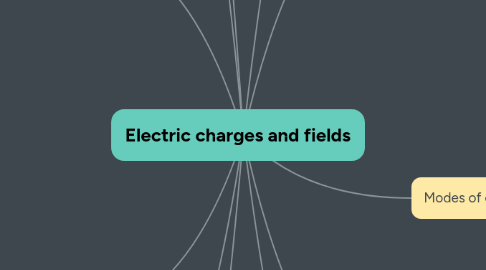
1. What are electric charges?
1.1. Intrinsic property of matter
1.2. SI UNIT - C or coulomb
1.3. +ve -ve or 0
2. Properties of charges
2.1. Quantised
2.1.1. Q = ne. → e = 1. 6 x 10¹⁹ C
2.2. Additivity
2.2.1. Q(net)= q1+q2+q3+q4+........+qn
2.3. Attraction and repulsion
2.3.1. Like charges repel Unlike charges attract
2.4. Conservation of charge
2.4.1. Charges can neither be created nor destroyed only transfered from one body to the other. The net charge in a system remains constant.
2.5. Force is generated between two charged bodies
2.5.1. Coulomb's law
3. Modes of charge transfer
3.1. Friction-
3.1.1. When two objects are rubbed against each other charges are transfered from one's body to the other giving +ve and -vely charged bodies
3.2. Conduction
3.2.1. the charge can be transfered by bringing a charged body in contact with a neutral conducting body via conduction
3.3. Induction
3.3.1. Induce a charge by bringing a charged body close to a neutral body without bringing them in contact.
4. Coulomb's law
4.1. F= (q1*q2)/(4πε⁰ × r²)
4.2. Force of a system of charges =F= q⁰/4πε⁰Σqi/r²i ×(ři) using superposition principle
5. Gauss's laws
5.1. Gauss law formulae
5.1.1. Spherical shell or any random shape Φ= q/ε⁰
6. Difference between mass and charge
6.1. Mass- only +ve Charge - +ve, 0 or -ve Mass- non quantised Charge-quantised Mass- depends on speed when v→ C Charge- independent of speed Mass - not conserved at high speeds Charge - conserved Mass - g force Charge - e force
7. Electric field
7.1. Electric field formula
7.1.1. E= (q/4πε⁰r²)(ř) where ř is unit vector representing direction of r vector
7.1.2. E= F/q⁰
7.2. Electric field for system of charges
7.2.1. E=(1/4πε⁰)Σqi/ri² ×(ři) Using superposition principle
7.3. Electric field lines
7.3.1. ▪︎Radially outward for +ve charge ▪︎Radially inward for -ve charge ▪︎field strength inversely proportional to r² ▪︎magnitude of field ~ density of field lines per unit cross sectional area
7.4. Some important points
7.4.1. ▪︎electric field is independent of test charge q⁰ ▪︎SI unit N/C ▪︎ if q⁰=1 then E=F ▪︎ electric field had spherical symmetry
8. Dipole moment
8.1. Torque (τ) due to Dipole in uniform electric field
8.1.1. τ= Ρ×Εsinθ Fnet=0 in uniform electric field
8.2. Field of an electric dipole
8.2.1. Point on axial line
8.2.1.1. E=2kp/r³
8.2.2. Point on equatorial plane
8.2.2.1. E=kp/r³
8.2.3. Ea=2Ee. ( a=axial e=equatorial )
8.3. What is electric dipole? 》a pair of =and opp. Charges -q and +q separated by a distance 2l is called dipole 》direction of dipole is from -q to +q
9. Electric Flux
9.1. Flux formula
9.1.1. φ= E.dscosθ
9.2. Area vector
9.2.1. Area vector = ds.ñ where ñ is Unit vector perpendicular to surface area
9.3. What is electric Flux? Number of field lines in a unit cross sectional area.
10. Continous charge distribution
10.1. Linear charge distribution (λ)
10.1.1. λ= q/Δl (l=length)
10.2. Surface charge distribution. (σ)
10.2.1. σ= q/Δs (s=area)
10.3. Volume charge distribution (ρ)
10.3.1. ρ= q/Δv (v is volume)
11. Gauss law application
11.1. Field due to infinitely long straight uniform charge wire (+ve charge)
11.1.1. Ε=2λ/4πε⁰r
11.2. Field due to uniformly charged plane sheet (+vely charged )
11.2.1. E=σ/2ε⁰
11.3. Field due to uniformly charged thin spherical shell (Gaussian surface of radius r And sphere of radius R )
11.3.1. (case 2~r<R) E=0 as no charge is present within gaussian surface as all the charge is present on circumference of thin spherical shell
11.3.2. (case1:r>=R) E=(σ/ε⁰)(R²/r²) = q/4πε⁰r²
